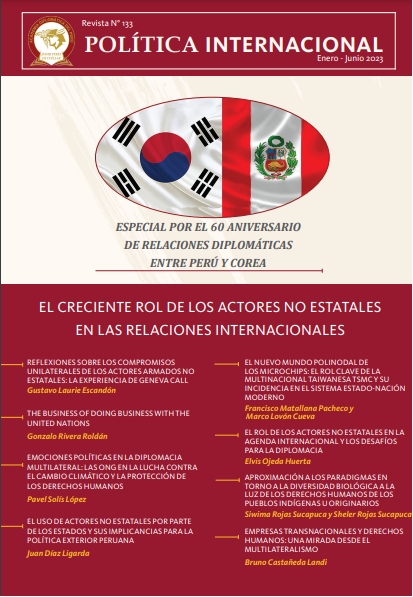Korea and its convergence with Peru
DOI:
https://doi.org/10.61249/pi.vi133.68Keywords:
national interests, Korea, Peru, national identity, convergence, strategic association, economic developmentAbstract
The article states, on the one hand, two stages which explain the evolution of Korea as an international actor: i) internal cohesion and ii) external projection; and, on the other hand by the analysis of the convergence of national interests the nature of Korea as a strategic partner of Peru. In the internal cohesion stage, the factors that underlie the modern State and current middle power are described and explained: i) national identity, ii) government policy, iii) business culture, and iv) the population. The external projection stage explains the transition of Korea as a middle power with important internal capabilities, since the end of the Cold War, to becoming a consolidated middle power with full projection of its national interests, during the first two decades of the XXI century. Finally, the convergence of the national interests of Korea and Peru is analyzed, revealing their strategic partnership and the great opportunity it represents for Peru.
Downloads
References
Barbé, E. (2007). Relaciones Internacionales. Ariel.
Biondi et Zapata (2017). Nómades electronales. Universidad Peruana de Ciencias Aplicadas. Centro de Estudios y Documentación Internacionales de Barcelona-CIDOB (2003). La política exterior de Corea del Sur. Anuario Internacional CIDOB 2002. Edición 2003, 495-496.
Chacón, A. (2008). Perceptions of the South Korean foreign policy towards Argentina, Brazil and Chile. Universidad de Chile.
Chacón, A. (2011). Percepciones de la Política Exterior de Corea del Sur hacia América Latina: Los casos de Brasil y México. Universidad California Los Ángeles.
Cho, S. (1994). The dynamics of Korean economic development. Institute for International Economics.
Chowdhury, A. (1993). The Newly Industrializing Countries of East Asia. Routledge.
Del Campo, J. (2010). Pearl Harbor: La historia secreta. Grafiamérica SAC.
Eckert, C. (1990). Korea, old and new: a History. Ilchokak Publishers.
García-Bedoya, C. (2008). Política Exterior Peruana: teoría y práctica. Academia Diplomática del Perú.
García-Blanch, F. (2002). Crecimiento económico en Corea del Sur (1961-2000): aspectos internos y factores internacionales. Ed. Síntesis.
García, D. (2008). Determinantes del crecimiento económico entre Corea del Sur y Chile (1960-2006). Departamento de Estudios Coreanos, UCLA.
Giné, J. (2008). Las prioridades de la política exterior coreana bajo la presidencia de Lee Myung-bak. Instituto Galego de Análise e Documentación Internacional (IGADI). http://www.igadi.org/artigos/2008/jgd_las_prioridades_politica_exterior_coreana.
htm
González, F. (2012). Relaciones de Comercio e Inversión del Perú con el Asia-Pacífico en Veinte Años de Política Exterior Peruana 1991- 2011 (209-242). IDEI – PUCP.
Haggard, S. (1990). Pathways from the periphery: the politics of growth in the newly industrializing countries. Cornell University.
Han, S. (2009). Breve historia de la República de Corea. Editorial de Universidad Dankook.
Kang, D. (2002). Crony capitalism: corruption and development in South Korea and the Philippines. Cambridge University Press.
Kang, Y. (1990). Continuing the dialogue: the third round of South-North Korean high-level talks. Seúl: Korean Overseas Information Service.
Keohane, J y Nye, J. (1989). Power and Interdependence. World Politics in Transition.
Kim, H. (1977). The unification Policy of South and North Korea: a comparative study. National University Press.
Kim, K. (1991). The Korean miracle (1962-1980) revisited: myths and realities in strategy and development. Kellogg Institute.
Nuechterlein, D. (1991). America Recommited: United States National Interest in a Restructured World. The University Press of Kentucky.
Page, J. (1994). The East Asian Miracle: Four lessons for Development Policy. NBER Macroeconomics Annual 1994. Volume 9, 219 – 282. http://www.nber.org/chapters/c11011.pdf
Robertson, J. (2007). South Korea as a Middle Power: Capacity, Behavior and Now Opportunity. International Journal of Korean Unification Studies, Vol. 16 (1), 155-159.
Robertson, J. (22 de marzo 2012). Time to start debate on Korea’s role as middle power. The Korea Herald. http://view.koreaherald.com/kh/view.php?ud=20120322001054&cpv=0
Roncagliolo, R. (2012). Presentación de la relación bilateral Corea-Perú. Bilateral Diplomacia & Negocios. (Nº 13, año 4, mayo 2022), 7-15.
Robinson, T. (1969). National Interests en James N. International Politics and Foreign Policy: A Reader in Research and Theory. Collier-Macmillan Limited, New York.
Rodrik, D. (1994). Getting interventions right: how South Korea and Taiwan grew rich. National Bureau of Economic Research.
The Korea Herald (2007). Insight into Korea: understanding challenges of the 21st century. Herald Media.
The Presidential Secretariat (1990). Korea: a nation transformed: Selected speeches of Roh Tae-woo. Seúl.
Yip, G. (2000). Asian Advantage: Key Strategies for Winning in the Asia-Pacific Region. Perseus Book Group.
Yoon, T. (1991). Guerra de Corea. Songsan Publishing Co.
Yoon, H. (2001). Development strategy in Korea reexamined: an interventionist perspective. The Social Science Journal, (38), 217-231.
Yun, T. (1984). Historia de Corea. Supeino Munjuawon.
Yu, M. (2008). Foreign Policy Orientation of the Lee Myung-bak Administration. IFANS Review, Vol. 16, 139-151.
Downloads
Published
How to Cite
Issue
Section
License
Copyright (c) 2023 Joshua Curay Ferrer

This work is licensed under a Creative Commons Attribution 4.0 International License.








